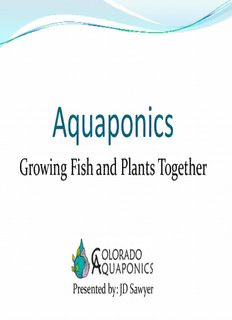
Aquaponics - Colorado State University - Fort Collins PDF
Preview Aquaponics - Colorado State University - Fort Collins
Aquaponics Growing Fish and Plants Together Presented by: JD Sawyer Aquaponics Defined The integration of: Aquaculture – Growing fish in a re-circulating system Ponos – The Greek word for growing plants with or without media Most people relate growing plants to hydroponics since both use nutrient rich water and both use soil-less media. How Aquaponics Works 1. Fish are raised in a tank 2. Water from the fish tank is pumped to the plants 3. Bacteria convert ammonia and nitrite to nitrate 4. Plants absorb the nutrient rich water 5. Filtered water is returned to the fish tank, clean Fish are Happy! Plants are Happy! We get more to eat! Why is it Considered Sustainable? Waste from fish is used to feed the plants Fish and plants create a polyculture producing two products Water is re-used in the re-circulating system Local food production, enhances the local economy and reduces food transportation Continuous organic fertilizer ATTRA – National Sustainable Agriculture Information Service Why Aquaponics? Uses a fraction of the water, about 10% of soil growing No need to purchase, store and apply fertilizer No soil-borne diseases, no tilling, no weeds Grow two food products together, protein and produce High fish stocking density, high crop yield No waste – hydroponics waste solution, aquaculture waste fish solids – aquaponics all waste is used No pesticides or herbicides, only fish fertilizer Food security, grow your own food, indoors, year-round Works in draught or places with poor soil quality Water use comparison Open-water net pens—“Infinite” number of gallons per pound of production Non-recirculating raceways and tanks—5,000 to 10,000 gallons per pound of production Non-recirculating ponds—500 to 1,000 gallons per pound of production Recirculating systems—5 to 10 gallons per pound of production Integrated aquaponics—Wastewater directed to greenhouses; no discharge Aquaponics Components Fish Tank Place to Grow Plants Water Pump(s) Air Pump Irrigation Tubing Water Heater (Optional) Filtration (Optional) Grow light (Optional) Fish and Plants Small Fish Tank Aquarium Stock Tank Half Barrel Rubber- made Tub Medium Sized Fish Tanks IBC – totes (make sure you know what was in them before) Bath tubs Plastic, Steel or Fiberglass Stock Tanks Build your own
Description: